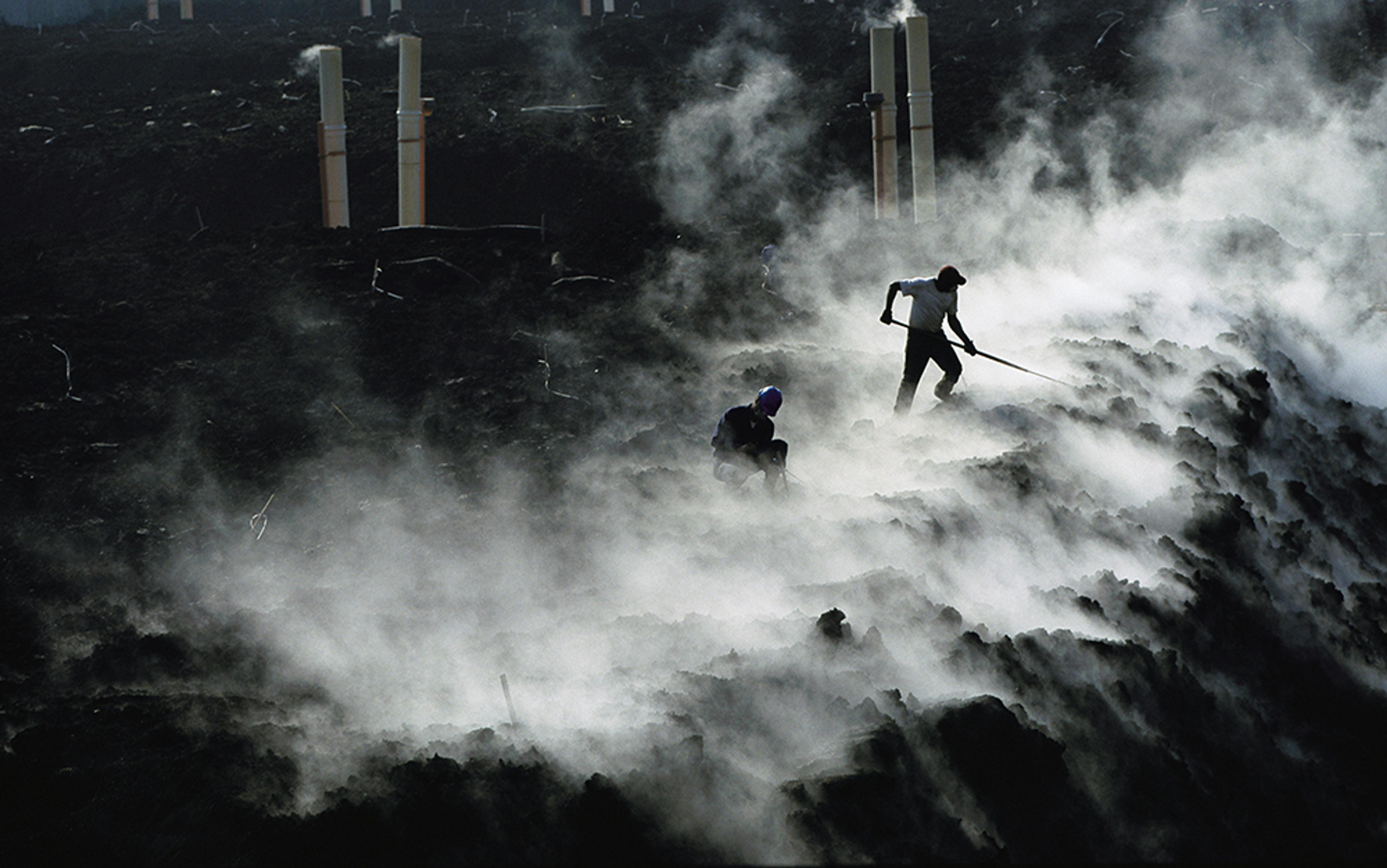A few times a month, I walk from my apartment in the rapidly gentrifying Lower Queen Anne part of Seattle towards one of the cafés in the booming South Lake Union neighbourhood. A good deal of the real estate along my route is controlled by Microsoft’s co-founder Paul Allen, and much of the demand is driven by Amazon’s inexorable rise.
My path takes me through Seattle Center, the complex built for the 1962 World Fair. On nice days, it is packed with tourists who arrive in swarms via monorail, headed for the Space Needle. Some continue to the newer Experience Music Project (EMP) Museum, a shimmering, peacock-purple Frank Gehry building funded by Allen. Inside the museum, an exhibit dedicated to Jimi Hendrix vies for attention with one about Star Trek.
Only a few cross the street to gawk at the Bill and Melinda Gates Foundation building. Inside, billions of dollars are directed towards the most unsexy innovation work in the world, such as vaccines and improved toilets. The exterior is as prosaic as the work that goes on inside; it looks like just another modern office building.
As a result of traffic snarls caused by the never-ending construction, even fewer make their way further east to the Museum of History and Industry (MOHAI) on the Lake Union waterfront, currently undergoing a $10 million expansion funded by Amazon’s founder Jeff Bezos. Among other exhibits, the MOHAI features a B-1, William Boeing’s first commercial plane.
The EMP Museum, the Gates Foundation, and the MOHAI form what I’ve dubbed the Titan Triangle of Seattle, a zone of violent urban terraforming. Sometimes, on my walks, an absurd image pops up into my head: Bezos, Gates and Allen standing like thousand-foot colossi at the three vertices, hammering away at the earth, with the ghost of Boeing looking on. Violence is the key word here. To scurry about within Titan Triangle is to be struck by the relentless violence — physical, financial, social, and psychological — of a process dubbed ‘creative destruction’. As popularised by the economist Joseph Schumpeter in the 1940s, this is the technology-driven unravelling and cohering of social orders in the human world.
But standing between the EMP Museum and the Gates Foundation, and taking in their opposing visions of innovation, I am equally struck by the fact that the transformative violence of creative destruction still appears to be governed by that apparently intractable question: how can you talk of colonies on Mars when there are starving children in Africa?
Billions of dollars are apportioned according to the logic of that question every year. And one has to wonder, do the financiers of creative destruction operate by better answers than the ones you and I trade at parties?
Banal though it is, the Mars-Africa question does capture all the tensions of creative destruction: old money versus new money; expanding frontiers versus laggard rears; future prosperity versus present traumas; growth versus inequality; unknown adventures versus avoidable tragedies.
But perhaps the central tension it caricatures is the one between necessity and possibility. It is the tension captured in the classic conflict between a strict single mom who makes sure the children eat their spinach, and an estranged deadbeat dad who shows up unpredictably, temporarily flush from gambling, to sneak the children off to Disneyland.
Fun encounters with Deadbeat Dad are what the kids look forward to, but Martinet Mom, who yells at them to do their homework, is the one who makes their daily life possible. The result is a continuous struggle between the forces of disruption and restoration.
Seattle Center embodies the Deadbeat Dad story: a showy, seductive and stimulating world of expanding frontiers. It is home to a narrative that restlessly reaches for new high-water marks of possibility: the moon! Mars! Time travel! Monorail! It is a narrative of booms, busts, unpaid debts, showboating impresarios and charmingly amoral chicanery.
Creative destruction is a process that starts neither with necessity nor with possibility, but with the kind of instinctive and imaginative self-expression that we call play
The Gates Foundation embodies the story of Martinet Mom: the drab, nurturing and boring world that brings up the rear. It is home to a narrative of spreadsheet-driven, rationally prioritised responses to questions of clear necessity: vaccines, better nursing practices, green revolutions, cheap prosthetics, and clean water for all. A narrative of pious self-effacement, slow change, invisible labour, and moral outrage.
Both camps lay claim to the adjective ‘real’. To admirers of the Deadbeat-Dad process, real innovation is Mars missions. To admirers of the virtuous Martinet-Mom process, real innovation is eliminating poverty in Africa.
In our world, the Deadbeat Dad/Martinet Mom dichotomy is an institutionalised one. Creative destruction is, for the most part, a sequestered dynamic. It has a home in our society, with a hidden inside and a visible outside. Mom in this world is publicly funded research in universities, government labs and corporations that sell to governments. Dad is the startup and finance sectors, looking for large and quick returns with as little government oversight as possible. Much of what Mom does is invisible. Dad’s antics routinely make the news.
The existence of the Mars-Africa question suggests that the home is a broken one. Mom pays the costs of raising the kids, both financial and psychological, turning bitter and unimaginative in the process. Dad reaps the fun rewards of parenthood on occasion, but mostly spirals down into deepening degeneracy. If Dad loses visitation rights, life for the kids turns into unbearable dreariness, driven entirely by Mom’s pain-aversion. If Mom accidentally drives off a fiscal cliff, pleasure-seeking Dad has no idea how to raise the kids, and abandons them entirely.
As the modern history of US innovation demonstrates very well, products that are not derived from decades of patient, unsexy government-funded research tend to be insubstantial and ephemeral, feeding manias, bubbles and even outright fraud. But without the connection to market forces provided by the startup and finance sectors, public-sector research is rapidly drained of imagination and becomes subservient to political anxieties. Either way, the process runs out of creative vitality and delivers the underwhelming piñatas of innovation today: the endless parade of trivial apps emerging from Silicon Valley on the one end, and nightmarishly mismanaged projects such as the F-35 Joint Strike Fighter on the other; products of Deadbeat Dad and Martinet Mom institutions, respectively.
As with any bad marriage, the central and easily overlooked question is the welfare of the children. But unlike most bad marriages, these kids are not ordinary kids. They are celebrity child stars: the ones who actually generate the family’s income.
The assumption that the adults in the family are the ones bringing in the money is perhaps the biggest misunderstanding of innovation processes. Here, the children are the individual generative new technologies — from steam engines to computers — that create new wealth. The story of each such technology tends to sprawl colourfully and untidily across multiple institutions and the interstices between them, often consuming them in the process. Efforts in technology development that strain too hard to colour within the lines typically destroy more wealth than they create.
Creative destruction is best understood as something that happens despite institutional supervision rather than because of it. It is a process that starts neither with necessity nor with possibility, but with the kind of instinctive and imaginative self-expression that we call play. Vaccines and Mars missions come later. Play comes first.
At best, parental supervision adds an element of safety, and reins in Lord of the Flies brutality. It seeks to protect the innocence of childhood, while managing wealth with the child’s future in mind. At worst, you get the story of mismanaged child stars. Mom is not just bitter and controlling; she is driving the kids towards an adolescent meltdown, trying to meet her own social aspirations. Dad is not just fun, he is a hustler looking to get rich quick, even if it means betraying the kids. It is the latter pattern that has become all too familiar in the past decade. In innovation, it is unhappy families that are all alike.
And as you might expect for a process that begins with imaginative play, every happy family is happy in its own way.
In our parable, if creative destruction sequestered within separate Deadbeat Dad and Martinet Mom institutions is a broken marriage, a happy marriage is a healthy innovation scene that focuses on the children. Between technological eras, as old institutions wane and new ones wax, the forces of creative destruction begin to play, weakly unsupervised, turning placid communities within the prevailing social order into illegible and tumultuous innovation scenes. Florence under the Medicis, the Cornish mining region at the turn of the 19th century, the Connecticut River Valley after the American Civil War, and what is now Silicon Valley after the Second World War are among the most familiar modern examples. Each is a distinct story rather than an instance of a pattern.
Within innovation scenes, rather than being sequestered in parental institutions old or new, creative destruction manifests as a fertile mix of unfettered individual genius and its subsuming, collective counterpart ‘scenius’, as the musician Brian Eno called it. In the US industrial revolution, Mom was institutions such as the Springfield and Harpers Ferry armories, and the Interstate Commerce Commission. Dad was the world of robber baron corporations. The scene, initially confined to the Connecticut Valley, eventually stretched all the way to Chicago. As innovation families go, this was a relatively happy one.
While scenes feed on themselves and snowball, the prevailing social order begins to unravel, and contours of the emerging order become visible. Uninhibited child-like play gives way to adolescent self-consciousness. Meek acceptance of parental authority gives way to increasingly forceful assertion of adult autonomy. It is a process marked by the pageantry of parties, staged events and peer-bonding among the future stewards of a brash new social order.
It is also the riskiest period in the maturation of a technological era. If old institutions retreat gracefully and emerging ones are built thoughtfully, a period of widespread prosperity follows. If either parent fights to retain control, or the kids fail to assert themselves sufficiently, progress falters. Failed transitions to adulthood give us the great technological stagnations of history: the Arabs in the 12th century, the Chinese in the 15th, Spain and Portugal in the 16th, and most recently, the Japanese. Whether it is Mom who turns martinet, or Dad who turns deadbeat, the result is the same. Progress stalls.
Nowhere in this authoritarian conception of progress is there any room for the sine qua non of creative destruction: undirected play
The history of technology is the story of transitions that worked, like the Industrial Revolution. It entered adolescence and began breaking free of the pre-modern social order at the 1851 Great Exhibition in London. Even as the worldwide mercantilist social order led by Britain began to unravel, the modern industrial social order began to take shape in America.
By the time of the 1967 Montreal Expo, the scenes were safely sequestered again within Cold War institutions, after the world had been violently transformed through great wars, thousands of inventions, and a massive reordering of society along urban lines.
These fairs were equal parts technological debutante balls, theaters of wild futurist speculation, and pure circus entertainment. Cities vied to host them to signal their arrival into industrial modernity. Nations used them as public throwdowns. Corporations used them to spar over emerging markets. Artists, urban planners and architects used them to hawk entire imagined lifestyles.
It was through world fairs that a rapidly developing US announced its arrival on the global stage. From London in 1851, when it stole Britain’s thunder, to Chicago in 1893, when it formally claimed Great Power status, the young nation had taught the world about everything from bloody mechanised killing and newspaper circulation wars to electric lighting and manufacturing with interchangeable parts.
But beneath the pageantry and posturing, these fairs were more than technological Olympics. They spawned both the enduring mainstream folkways of modernity, such as suburban living and business-class air travel, as well as its dead-end subcultures, such as the world of flying-car loyalists. The fairs could do this because, fundamentally, they were large-scale exercises in what futurists call design fiction: indirect explorations of possible futures mediated by speculative, but tangible artifacts.
Some fair fictions became facts, such as the Colt revolver (London, 1851), the Otis elevator (New York, 1853), the Bell telephone (Philadelphia, 1876) and, perhaps most theatrically, electricity (a decade-long arrival between Chicago, 1893, and Paris, 1900). Others, like monorails, never quite lost their fictional quality.
After Expo 67 in Montreal, widely regarded as the apogee of world fairs, the focused energy that drove the century-long spectacle dissipated. The kids had grown up and created their own parental institutions, shaped by the Cold War.
But the peace would not last. Just two years later in 1969, a novel network called ARPANET came alive between one computer at the University of California in Los Angeles and another 360 miles north in the Stanford Research Institute at Menlo Park. Elsewhere, researchers at Bell Labs in New Jersey commandeered a ‘little-used PDP-7 in a corner’ for a modest little project they called UNIX. And two teenagers, both named Steve, met at Homestead High School in Cupertino, California.
While the world watched humans walk on the Moon — arguably the dead-end grand finale of the century of world fairs — a new generation of child prodigies was sneaking out to party on an entirely different front.
To find the modern descendant of the world fairs, you need look no further than Silicon Valley, a never-ending party of experimental lifestyles, speculatively inhabited social orders, and design fictions masquerading as businesses: startups.
It is the peculiar combination of openness to lifestyle experimentation and technological talent that makes the region both spectacularly effective and frustratingly limited in its potential. To prove that the technology-crazy will adopt a product is to prove very little. They are not so much early adopters as world-fair visitors in a mood to experiment. Yet, impressing the experimenters is a necessary rite of passage on the road to the creation of new wealth. Mingling among the gawkers and groupies of innovation are the moneyed shoppers: the venture capitalists deputised by the stewards of the old economy to find new homes for old money.
In this particular happy family, Mom is institutions such the Defense Advanced Research Projects Agency (DARPA), the Stanford Research Institute (now SRI International), Bell Labs, and the Palo Alto Research Center (PARC). Dad is companies such as Fairchild Semiconductor, IBM, Hewlett-Packard, and Xerox. The child is networked personal computing: the steam engine of our times.
If old institutions retreat gracefully and emerging ones are built thoughtfully, a period of widespread prosperity follows
The contrast between the maternal and paternal genealogies of networked personal computing was sharply revealed in October 2011, when two giants of the industry, Steve Jobs and Dennis Ritchie, died within a week of each other. Ritchie — the co-inventor of the C programming language and the Unix operating system — is practically unknown outside of technology circles. He spent his career at Bell Labs, a storied institution born of an older technology revolution. Along the way, he earned a PhD from Harvard and the most important prize in computer science, the Turing Award.
Meanwhile, Jobs dropped out of college to grow an iconic company out of a garage, in the process becoming a celebrity billionaire and the subject of a bestselling biography.
If the world fair in Chicago in 1893 marked the coming of age of industrial technology and the rise of the American continent, the passing of Ritchie and Jobs is a suitable marker for the coming of age of information technology and the rise of the virtual world.
It has put us, once more, into an era defined by institution-building, comparable to the second half-century of world fairs. What we do now will determine whether the next family will be a happy one or one engaged in a predictable toxic custody battle for the future of innovation. The disparity in the relative attention being paid to the legacies of Jobs and Ritchie, and the increasingly frantic Mars-Africa discussion, do not bode well.
The logic of the Mars-Africa question is ultimately the logic of political objectives for any innovation institution: predictable growth in middle-class wealth and standards of living, revitalisation of failing industries, and national competitiveness strategies crafted by solemn committees of developmental economists. What is common to all these objectives is that they seek to inject new wealth into existing social orders without disrupting them, and to deliver on the political fiction of steady, harmonious and deterministic growth.
This fiction rests on assumptions about how controllable creative destruction processes are. That’s creative destruction with the destruction censored, and the creation tamed and directed towards prepared narrative pathways of possibility and necessity. We even had a triumphalist and authoritarian high-modernist term for the process that can only be used ironically today: the march of progress.
Central to this assumption of controllability is the denial of the need for new institutions born of inchoate young scenes. What politics hopes for is the perpetuation of existing institutions. Its fond hope is that new generative forces can be yoked to the purposes of old institutions; that the message can remain independent of the medium. Politics wants questions of necessity and possibility to both remain unchanged. It hopes that the forces of the computing revolution will deliver on the old possibilities and necessities of Mars colonies and an Africa developing along European lines, rather than pursuing new possibilities and new necessities.
Politics hopes that there is such a thing as too big to fail. That there can be another Sputnik moment.
Out of this position comes the modern cargo cult of progress, conceived of as a bureaucratic feedback-loop flowchart. Insert science, technology, engineering and mathematics (STEM) grants here, generate basic research using the scientific method, encourage innovation via tax breaks to turn the basic research into growth by way of shareholder value. Levy taxes on new wealth. Rinse and repeat.
Nowhere in this authoritarian conception of progress is there any room for the sine qua non of creative destruction: undirected play. So it is not surprising that anxieties triggered by an assertive new social order provoke reactions that seek to bolster Mom and Dad, with predictable results.
The levers of reactionary influence available to politics are coarse: large-scale deployments of tax dollars for Mom, tax-breaks and easy credit for Dad. A recipe for breaking up happy families. The measures available to monitor the theatre of value-creation are the ones championed by vociferous parents. Upstream in the cargo-cult process, we have the measures championed by Martinet Mom: performance of school districts on standardised tests, PhDs granted, papers and patents produced. Downstream, we have Deadbeat Dad, cadging special favours and breaks.
When the music stops, and the money begins to dry up, politics turns into a deadlocked contest between Martinet Mom and Deadbeat Dad, shaped by a nauseating mix of fear and greed. It does not matter who wins. The children lose.
To break the gridlock and learn how to work with more meaningful levers requires a leap of imagination that has so far proved impossible — a narrative that accepts that progress is not just consistent with uncertainty, it requires it. The more we try to dictate the precise nature of prosperity, the less we are able to create it.
It is hard to imagine a model of creative destruction that treats non-deterministic play as sacred, and deterministic process as profane. Institutions, as we have been able to conceive them so far, are deterministic beasts, not playful ones. For Martinet-Mom institutions, security is sacred and pain is profane. For Deadbeat-Dad institutions, romance is sacred and inertia is profane. When the two are divorced, romance sours into pain, security ossifies into inertia, and revolutions are stillborn.
Yet, neither notion of the sacred captures play. Play turns possibility into necessity via a sense of absolute aesthetic certainty, and necessity into possibility by irreverent undermining of pious dogmas.
To believe that tablet computing must be a certain way is to answer a Deadbeat Dad question with Martinet Mom sensibilities: the result is the iPad. To consider the possibility that entrepreneurship, rather than foreign aid, is the solution to hunger in Africa, is to answer Martinet Mom questions with Deadbeat Dad sensibilities: the result is cheap smartphones and Nigerian scamsters driving leapfrog development of a sort that has no analog in European history.
For either pattern to be possible, it is play that must be viewed as sacred. Not play as conceived by adults — idle time to be filled with purchased stimulation — but play as children practice it. Play as a state of deep absorption rather than attention deficit disorder, intense relationships rather than private self-indulgence, tumultuous emotions rather than overstimulation, uncertainty rather than scripts, everyday objects repurposed for play rather than manufactured toys feeding addictions.
It is the super-rational embrace of uncertainty and risk that the American anthropologist Clifford Geertz called deep play, in his 1972 study of Balinese cockfighting rituals. Play that unfolds in an angel’s workshop, rather than a devil’s. And that, ultimately, is why the Mars/Africa question troubles me. It represents a fear of the unknown, and the unknown is the very object of innovation.






